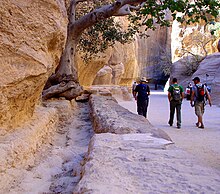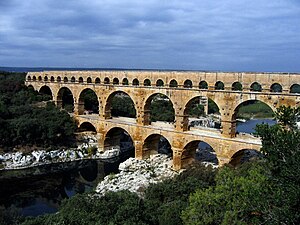User:Nankai/Aqueduct (watercourse)
An aqueduct is a watercourse constructed to convey water. In modern engineering, the term aqueduct is used for any system of pipes, ditches, canals, tunnels, and other structures used for this purpose[1] The term aqueduct often refers specifically to a bridge on an artificial watercourse.[2] The word is derived from the Latin aqua ("water") and ducere ("to lead").[3] There are many other names for an artificial watercourse, including leat, aquecia, flume, water race.
Ancient aqueducts
[edit]
Although particularly associated with the Romans, aqueducts were devised much earlier in Greece and the Near East and Indian subcontinent, where peoples such as the Egyptians and Harappans built sophisticated irrigation systems. Roman-style aqueducts were used as early as the 7th century BCE, when the Assyrians built an 80 km long limestone aqueduct, which included a 10 m high section to cross a 300 m wide valley, to carry water to their capital city, Nineveh.[4]
India
[edit]The Indian subcontinent is believed to have some of the earliest aqueducts. Evidence can be found at the sites of present day Hampi, Karnataka. The massive aqueducts near river Tungabhadra supplying irrigation water were once 15 miles (24 km) long.[5] The waterways supplied water to royal bath tubs.
Oman
[edit]In Oman from the Iron Age Period (found in Salut, Bat and other sites) a system of underground aqueducts called Falaj were constructed, a series of well-like vertical shafts, connected by gently sloping horizontal tunnels. There are three types of Falaj
- Daudi (داوودية) with underground aqueducts
- Ghaili (الغيلية ) requiring a dam to collect the water
- Aini (العينية ) whose source is a water spring
These enabled large scale agriculture to flourish in a dry land environment
Persia
[edit]In Persia from early times [vague] a system of underground aqueducts called Qanat were constructed, a series of well-like vertical shafts, connected by gently sloping tunnels. This technique:
- taps into subterranean water in a manner that delivers water to the surface without need for pumping. The water drains relying on gravity, with the destination lower than the source, which is typically an upland aquifer.
- allows water to be transported long distances in hot dry climates without losing a large proportion of the source water to seepage and evaporation.
Petra, Jordan
[edit]Throughout Petra, Jordan, Nabataean engineers took advantage of every natural spring and every winter downpour to channel water where it was needed. They constructed aqueducts and piping systems that allowed water to flow across mountains, through gorges and into the temples, homes and gardens of Petra’s citizens. Walking through the Siq, one can easily spot the remains of channels that directed water to the city center, as well as durable retention dams that kept powerful flood waters at bay.
Greece
[edit]On the island of Samos, the Tunnel of Eupalinos was built during the reign of Polycrates (538-522 BC). It is considered an underground aqueduct and brought fresh water to Pythagoreion for roughly a thousand years.
Roman
[edit]
Roman aqueducts were built in all parts of the Roman Empire, from Germany to Africa, and especially in the city of Rome, where they totaled over 415 km. The aqueducts supplied water to public baths and for drinking water, in large cities across the empire, and set a standard of engineering that was not surpassed for more than a thousand years. Bridges, built in stone with multiple arches, were a distinctive feature of Roman aqueducts and hence the term aqueduct is often applied specifically to a bridge for carrying water.[6]

South America
[edit]Near the Peruvian town of Nazca, an ancient pre-Columbian system of aqueducts called Puquios were built and are still in use today. They were made of intricately placed stones, a construction material widely used by the Nazca culture. The time period in which they were constructed is still debated, but some evidence supports circa A.D. 540–552, in response to drought periods in the region.[7]
North America
[edit]When Europeans saw the Aztec capital Tenochtitlán, early in the 16th century CE, the city was watered by two aqueducts. One of these, Chapultepec Aqueduct, built circa 1420 CE, was rebuilt by the Spanish almost three hundred years later. Originally tracing part of its path over now-gone Lake Texcoco, only a fragment remains in Mexico City today.
Sri Lanka
[edit]Extensive usage of elaborate aqueducts have been found to have been used in Ancient Sri Lanka.
Modern aqueducts
[edit]The examples and perspective in this article may not represent a worldwide view of the subject. (July 2012) |
In modern times, the largest aqueducts of all have been built in the United States to supply the country's biggest cities. The Catskill Aqueduct carries water to New York City over a distance of 120 miles (190 km), but is dwarfed by aqueducts in the far west of the country, most notably the Colorado River Aqueduct, which supplies the Los Angeles area with water from the Colorado River nearly 400 km to the east and the 701.5 mi (1,129 km) California Aqueduct, which runs from the Sacramento-San Joaquin River Delta to Lake Perris. The Central Arizona Project is the largest and most expensive aqueduct constructed in the United States. It stretches 336 miles from its source near Parker, Arizona to the metropolitan areas of Phoenix and Tucson.
Uses
[edit]
Historically, agricultural societies have constructed aqueducts to irrigate crops. Archimedes invented the water screw to raise water for use in irrigation of croplands.
Another use for aqueducts is to supply large cities with drinking water. Some of the Roman aqueducts still supply water to Rome today. In California, United States, three large aqueducts supply water over hundreds of miles to the Los Angeles area. Two are from the Owens River area and a third is from the Colorado River.
In more recent times, aqueducts were used for transportation purposes to allow canal barges to cross ravines or valleys. During the Industrial Revolution of the 18th century, aqueducts were constructed as part of the boom in canal-building.
In modern civil engineering projects, detailed study and analysis of open channel flow is commonly required to support flood control, irrigation systems, and large water supply systems when an aqueduct rather than a pipeline is the preferred solution.
In the past, aqueducts often had channels made of earth or other porous materials but significant amounts of water are lost through such unlined aqueducts. As water gets increasingly scarce, these canals are being lined with concrete, polymers or impermeable soil. In some cases, a new aqueduct is built alongside the old one because it cannot be shut down during construction.
Notable aqueducts
[edit]Ancient Greek aqueducts
[edit]- The Eupalinian aqueduct on the Greek island of Samos
Roman aqueducts
[edit]Other aqueducts
[edit]- Wignacourt Aqueduct, Malta; built in the 16th century to transport water from the old capital city of Malta, Mdina to the new capital city Valletta; today, only part is visible in the localities of Balzan, Birkirkara and Santa Venera
- Aqueduct St-Clément, Montpellier, France – 17th century
- Bar Aqueduct, Montenegro – 16th century
- Águas Livres Aqueduct, in Lisbon, Portugal (built 1731–1748)
- Aqueduto de Óbidos, in Óbidos, Portugal (built 1570)
- Aqueduto de Setúbal in Setúbal, Portugal (built 1696)
- Aqueduto dos Pegões in Tomar, Portugal (built 1593)
- Água de Prata Aqueduct, in Évora, Portugal (built 1531–1537)
- Santa Clara Aqueduct, in Vila do Conde, Portugal
- Carioca Aqueduct in Rio de Janeiro, Brazil (built 1744–1750)
- Aqueduct of Teruel, Spain
- Roquefavour aqueduct, France – built between 1842 and 1847
- Winnipeg Aqueduct, Manitoba, Canada – built between 1915 and 1919
- Canal de l'Aqueduc, Quebec, Canada
- Päijänne Water Tunnel, a 120-kilometer long underground aqueduct (continuous tunnel) connecting lake Päijänne to Greater Helsinki
- Wan Mat Saman Aqueduct, Kedah, Malaysia – built between 1900 and 1909
- Surviving Spanish aqueducts in Mexico:
- Aqueduct of Querétaro, Mexico – built between 1726 and 1738, 1.3 km long and featuring 74 arches
- Aqueduct of Morelia, Michoacán, built between 1735 and 1738
- Aqueduct of Acámbaro, Guanajuato, built in 1528[8]
- Chapultepec aqueduct, Mexico D.F.
- Kavala aqueduct, 16th-century Ottoman aqueduct in Kavala, Greece
- Levadas, 1,350 miles (2,170 km) of 17th century aqueducts on the Portuguese island of Madeira
- Espada Aqueduct, built 1735, in San Antonio, Texas, United States
- Quabbin Aqueduct, 24.6-mile (39.6 km) long tunnel, in Massachusetts, United States
- Chicopee Valley Aqueduct, 13.1-mile (21.1 km) long, in Massachusetts, United States
- Central Arizona Project Aqueduct
- California Aqueduct, a 715 mi (1,151 km) combination of canals, pipelines and tunnels, United States.
- Delaware Aqueduct, in New York State, United States – at 85 miles (137 km) long, the world's longest continuous underground tunnel
- Sooke Flowline located on Vancouver Island, Canada, is a 44 kilometres long, gravity fed concrete pipe which provided water to the City Of Victoria for 55 years
- National Water Carrier of Israel located in Israel, is a 130 km long system of giant pipes, open canals, tunnels, reservoirs and large scale pumping stations to transfer water from the Sea of Galilee in the north of the country to the highly populated center and arid south, built between 1953 and 1964
Gallery
[edit]-
View from inside a Roman aqueduct from the Pools of Solomon to Jerusalem
-
An entrance to the ancient Puquios, near Nazca
See also
[edit]- Earthquake engineering
- Goldfields Water Supply Scheme
- Leat
- List of aqueducts
- List of canal aqueducts in the United Kingdom
- List of Roman aqueduct bridges
- Pipeline – some used to carry water
- Roman architecture
- Roman engineering
- Sanitation in Ancient Rome
- Water resources
Notes
[edit]- ^ "aqueduct", Britannica CD 2000
- ^ "aqueduct", Britannica CD 2000
- ^ "aqueduct", Britannica CD 2000
- ^ Thorkild Jacobsen and Seton Lloyd, Sennacherib's Aqueduct at Jerwan, Oriental Institute Publication 24, University of Chicago Press, 1935]
- ^ A forgotten empire (Vijayanagar): a ... – Google Books
- ^ "aqueduct", Britannica CD 2000
- ^ Unix.oit.umass.edu
- ^ Mexico – Travel
References
[edit]- Sextus Julius Frontinus, De Aquaeductu Urbis Romae (On the water management of the city of Rome), Translated by R. H. Rodgers, 2003, University of Vermont
- Aqueduct entry from Encyclopædia Britannica Eleventh Edition
- Chanson, H. (2002). Certains Aspects de la Conception hydrauliques des Aqueducs Romains. ('Some Aspect on the Hydraulic Design of Roman Aqueducts.') Journal La Houille Blanche, No. 6/7, pp. 43–57 (ISSN 0018-6368)
- Chanson, H. (2008). "The Hydraulics of Roman Aqueducts: What do we know? Why should we learn?" in Proceedings of World Environmental and Water Resources Congress 2008 Ahupua'a, ASCE-EWRI Education, Research and History Symposium, Hawaii, USA, Invited Keynote lecture, 13–16 May, R.W. Badcock Jr and R. Walton Eds., 16 pages (ISBN 978-0-7844-0976-3)
External links
[edit]
Category:Water Category:Bridges by mode of traffic Category:Water transport infrastructure Category:Water supply Category:Routes


